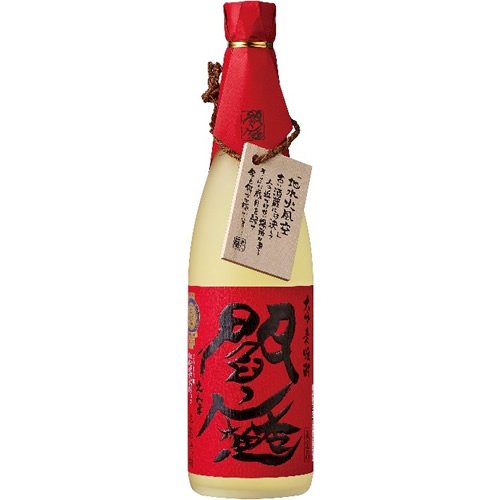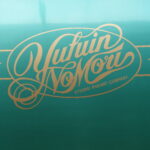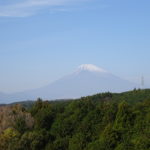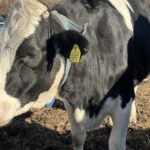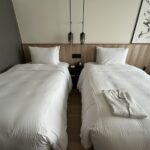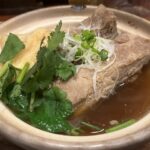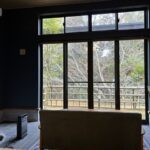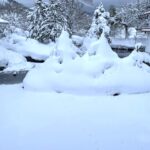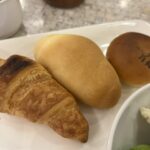“Jigoku Meguri” in Beppu and hot springs in Yufuin
I want to avoid the crowds and enjoy a relaxing soak in a nice hot spring.
I wanted to take a bath in Yufuin hot springs, one of Japan’s famous hot springs, so I took my first flight in about a year and a half to Beppu Airport.
Yufuin is located on flat land at the foot of Mt. Yufu, so if you are visiting from Honshu or Shikoku, it seems convenient to head from Beppu.
There are direct flights from the Kanto and Kansai areas, and ferries from Shikoku to Matsuyama and Uwajima.
Oita Airport, which I used this time, had not declared a state of emergency during the coronavirus pandemic, but the airport shuttle bus was surprisingly quiet.
After enjoying Beppu’s “Jigoku Meguri”, head to Yufuin
From Beppu Station to Yufuin Station, it is convenient to use local buses or the direct sightseeing Rapid bus called “Yufurin”.
Yufurin departs from Beppu Station and also stops at Kannawa Jigoku Meguri Station, a tourist attraction in Beppu, making it very convenient for sightseeing on Jigoku Meguri before heading to Yufuin.
Since I’ve come all the way to Beppu, I’ll take a detour to the Beppu ”Jigoku Meguri” before checking in to my tonight’s High class Hotel in Yufuin called “Ryotei Tanokura”.
(My stay at Ryotei Tanokura was a very nice, high-class, calm inn, so please take a look at the article at the end of this article.)
The Beppu Hell Tour is called ○○ Hell, and is a place where hot springs with various properties are maintained and each one is used as a tourist attraction. There are pools of hot water that look like concrete gushing out, and you can enjoy looking at them like an attraction.
There are seven hells in total, and it is convenient to purchase a common admission ticket (2,200 yen for one adult including tax).
To prevent the spread of infection, instead of handing your ticket to the staff, you will tear it off yourself and put it in the collection box.
On the Beppu Jigoku Meguri website, there is a discount ticket for the entrance fee, and if you print it out and bring it with you, you will get a 10% discount.
From Beppu city, it is recommended that you aim for Kannawa Bus Stop, especially if you have a lot of luggages.
Starting from this bus stop, there are five “Jigoku” at the top and two “Jigoku” at the bottom.
The upper five “Jigoku” are within walking distance, so after enjoying the five, you can return to Kannawa bus stop and visit the lower ones, “Chi no Ike Jigoku” and “Tatsumaki Jigoku”. You can also head up to see its Jigoku.
“Chi no Ike Jigoku” and “Tatsumaki Jigoku” are a little far apart, so it’s about a 10 minute bus ride from Kannawa bus stop.
You will need to take a local bus, not an express.
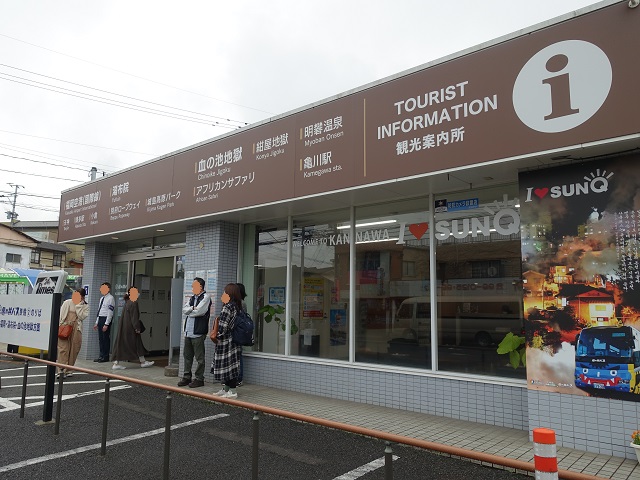
鉄輪バス停
There are coin lockers inside the bus stop facility, so it is very convenient to leave your luggage there.
Please note that there are no coin lockers in each facility.
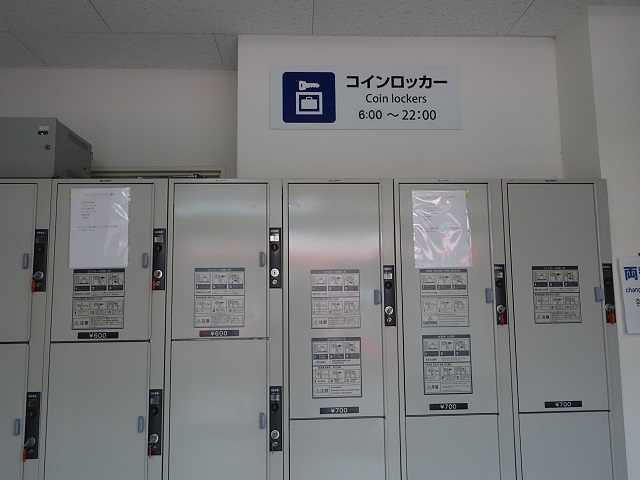
鉄輪バス停のコインロッカー
I used this Kannawa bus stop as my base for touring the upper five facilities.
白池地獄 (Shiroike Jigoku)
I go to Shiraike Jigoku near the bus stop.
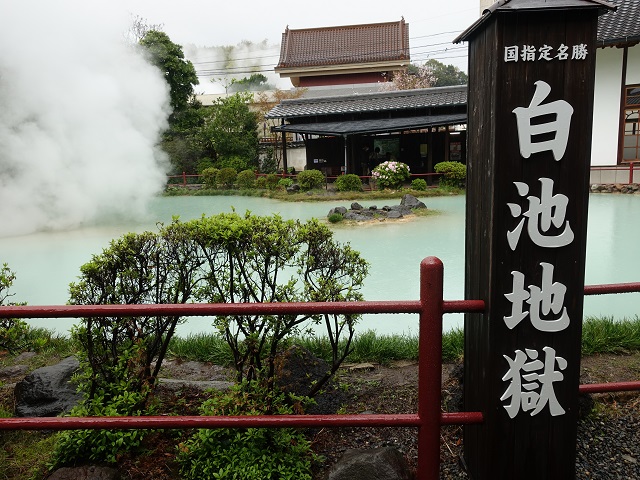
別府地獄めぐりの白池地獄
The indescribable milky green feels mysterious.
At first glance, it looks like just a pond, but the steam spewing out from around the center of Shiraike reminds you that it is a hot spring.
If you look at it from a distance, the shape of the pond is heart-shaped.
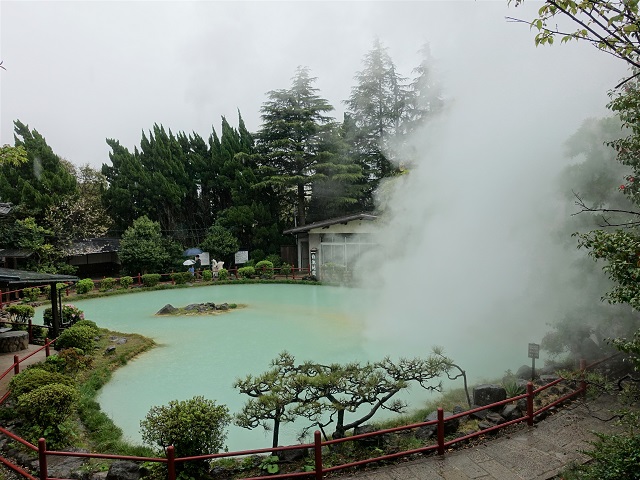
白池地獄の池の形がハートになっている
Here you can also see pirarucu and piranhas being bred using the hot springs.
鬼山地獄(Oniyama Jigoku)
Immediately after leaving ”Shiraike Jigoku”, you will find ”Oniyama Jigoku” up the alley called Miyuki-zaka.
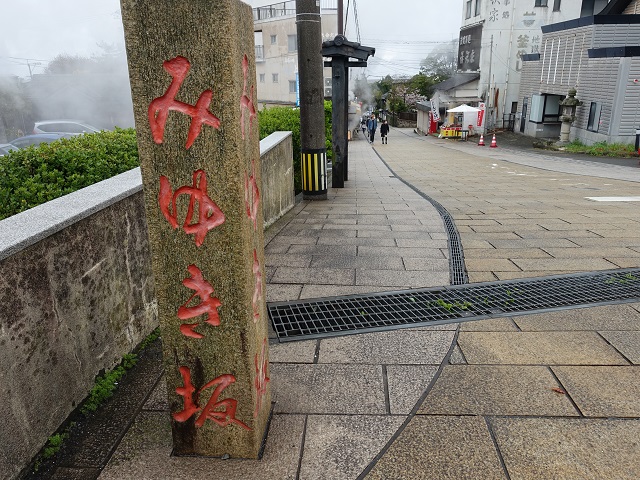
When you enter the entrance, a demon statue will greet you.

鬼山地獄の鬼
I didn’t really understand why it was named Oniyama, but what’s amazing is this steam.
There was supposed to be a hot spring pond on the other side of the fence, but the white steam was so intense that I couldn’t see the pond clearly.
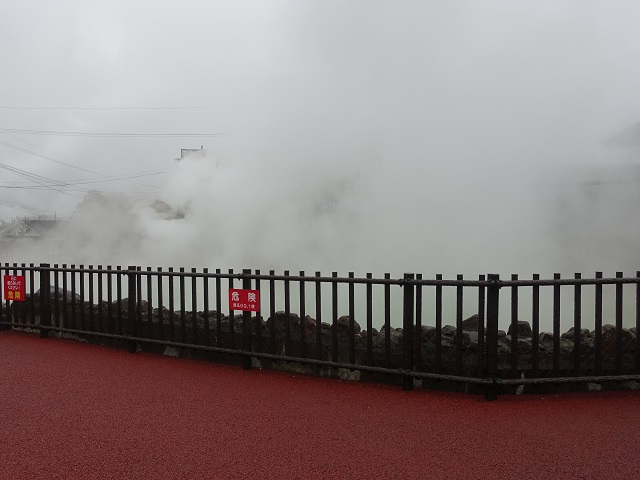
鬼山地獄の蒸気 Steam of Oniyama Jigoku
According to the explanation inside the museum, this steam creates enough pressure to move 1.5 cars.
Also, this steam is said to be suitable for growing crocodiles, and the Malaysian Prime Minister at the time visited this place in 1994 as they were breeding crocodiles imported from Malaysia.
The crocodile was definitely big and scary. . I took a quick tour around the building and excused myself early.
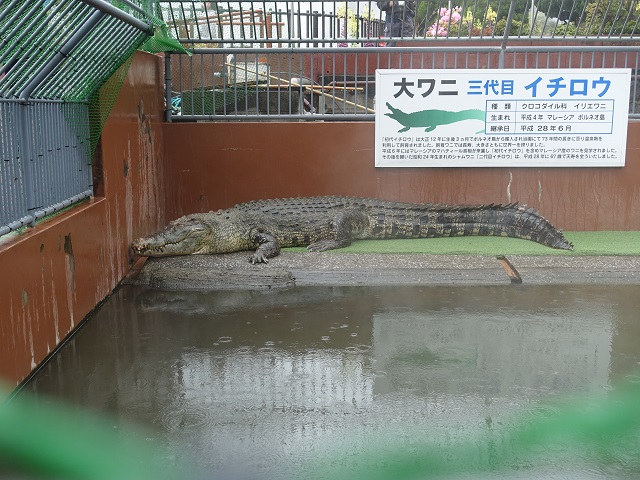
3代目だけどイチロウ Ichiro
かまど地獄 (Kamado Jigoku)
I have arrived at the “Kamado Jigoku”.
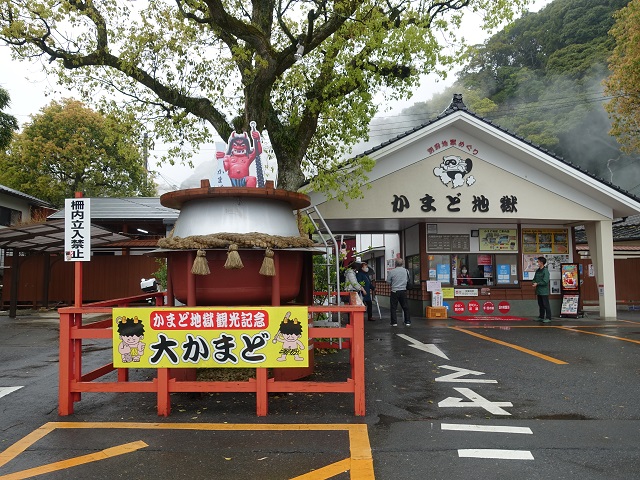
There is a parking lot in front of the facility, so it is convenient for those using a car to tour.
Here, there are several hot springs with different temperatures, divided into sections from 1-chome (1st Avenue) to 6-chome (6th Avenue).
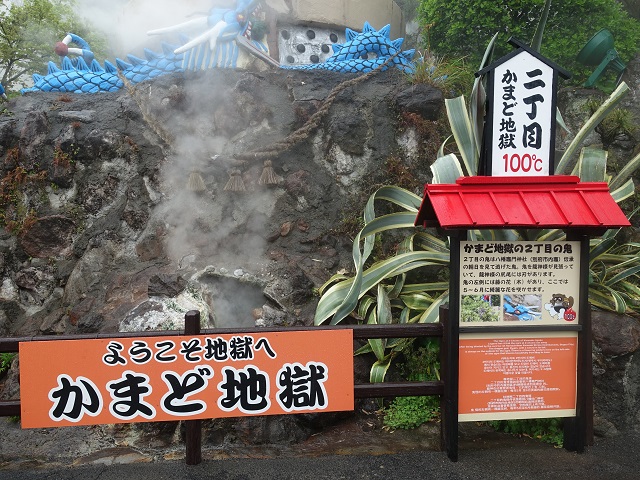
This is 100 degree (Celsius) hot water.
At high temperatures, the water is almost transparent.
Depending on the geology where the hot water comes from and the temperature there, the hot spring water can be either milky brown or reddish brown.
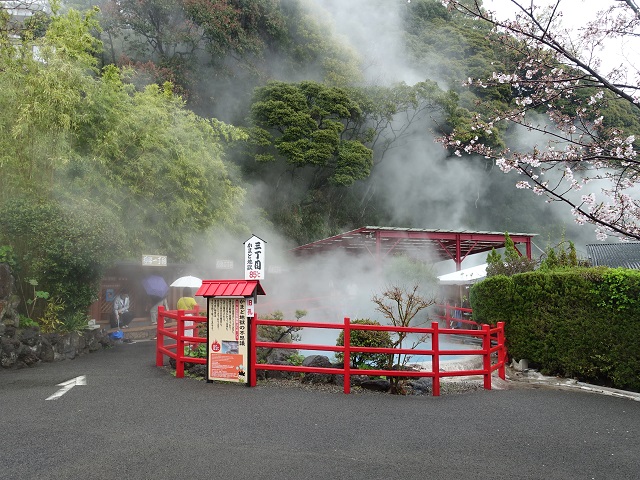
This is 85 degree (Celsius) hot water.
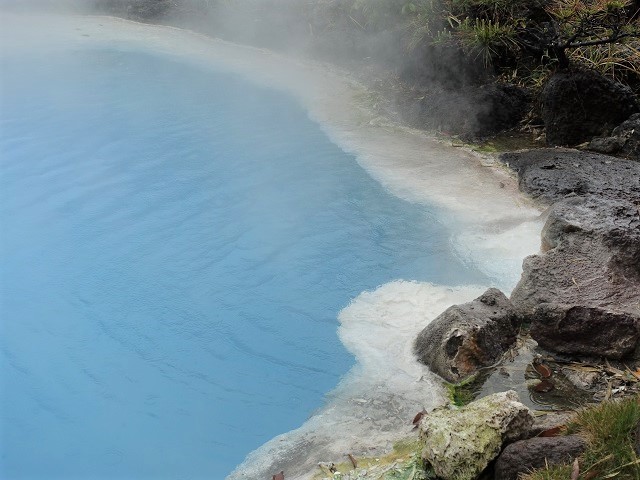
かまど地獄85度の湯
And this is a 95 degree hot spring on the same premises.
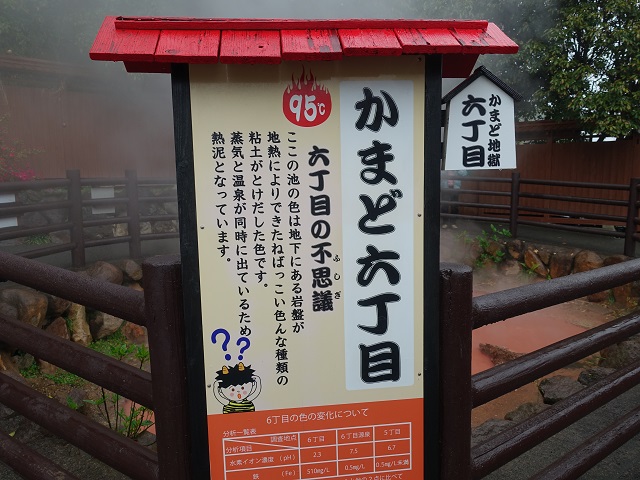
Apparently the soil contains a lot of iron, so the hot water is quite reddish brown.
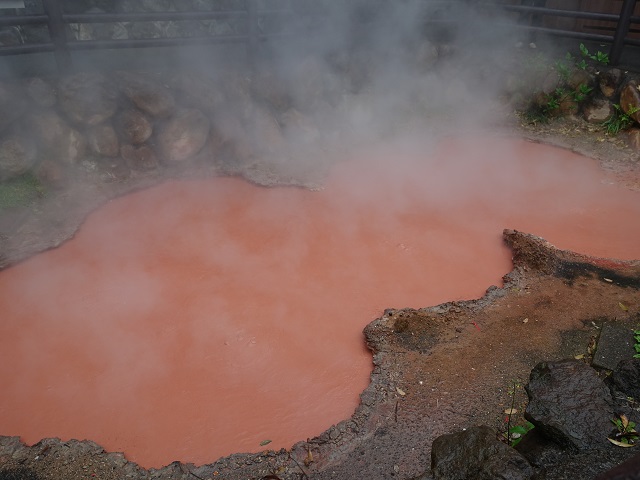
かまど地獄の95度の湯
Kamado Jigoku has drinking hot springs, a shop, and a footbath area, so many families with children enjoyed it.
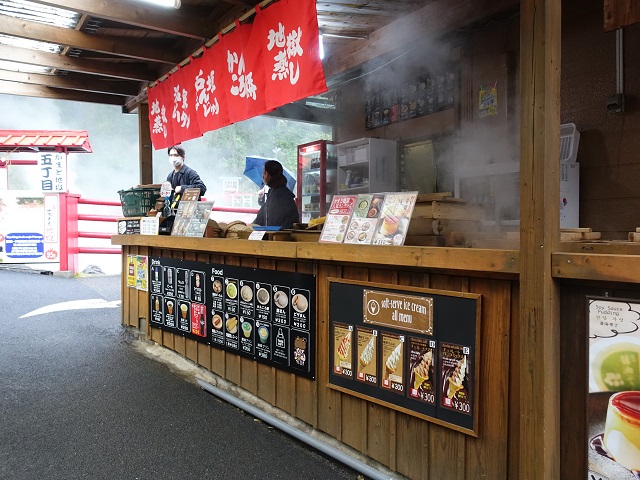
かまど地獄の売店
We also recommend the mini mini show that is held next to the shop. If you come across a scene where this is being done, you’re lucky. The person in charge will perform a performance that will make you feel like the hot springs are gushing out.
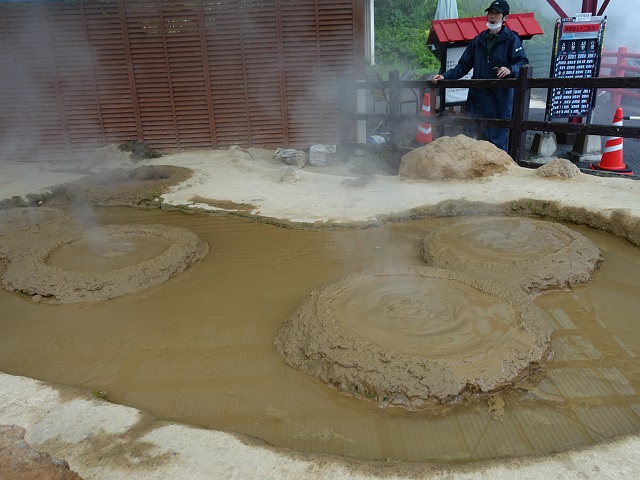
かまど地獄のミニミニショー
海地獄へ(Umi Jigoku)
If you go up the Jigoku Meguri Street next to Kamado Jigoku, you will arrive at ”Umi Jigoku”.
Here is the sign of Jigoku Meguri Street.
You go up this street.
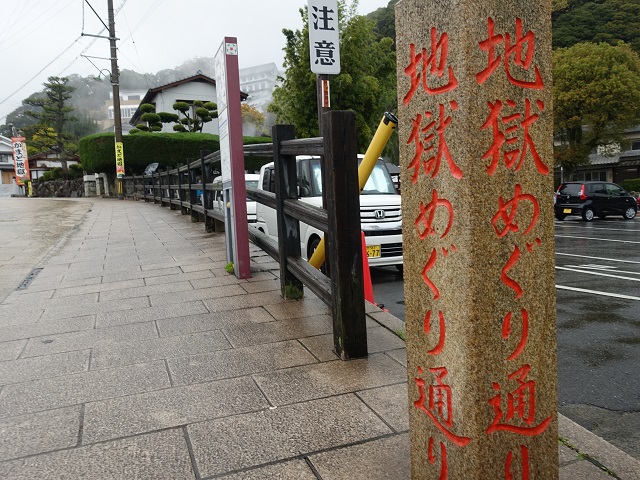
We have arrived at ”Umi Jigoku”.
It’s just a few minutes walk away.
There are quite a lot of spacious parking lots here, so it seems convenient to get there by car.
Enter through the splendid thatched roof gate.
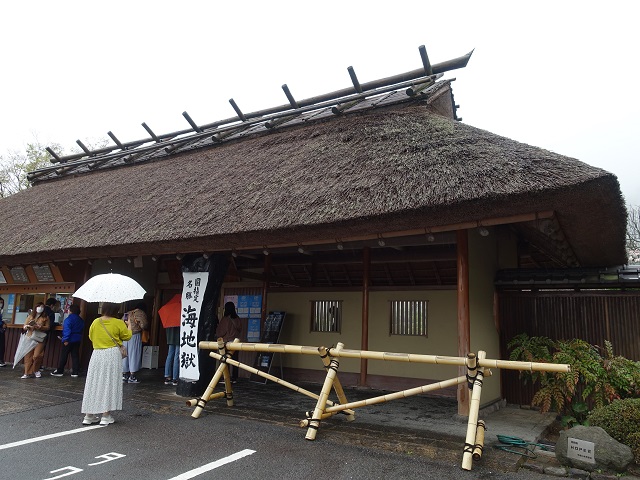
This is said to boast the largest site in Hell, and is spacious inside, with a footbath and a fairly large souvenir shop, so you can enjoy a leisurely tour.
There is also a large lotus pond, so you can enjoy a wonderful Japanese garden.
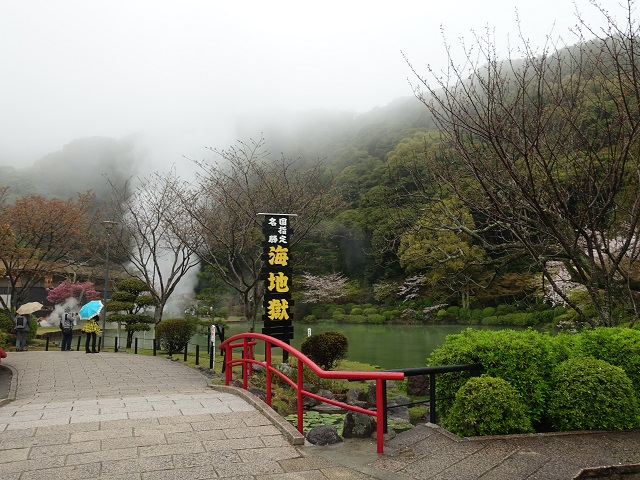
It was cherry blossom season, so the cherry blossoms were beautiful.
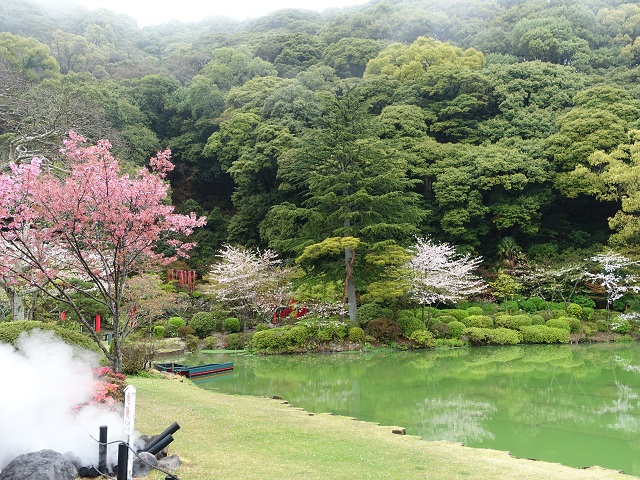
桜が緑に映えて美しい
The footbath space is also spacious, so please feel free to bring your own towel.
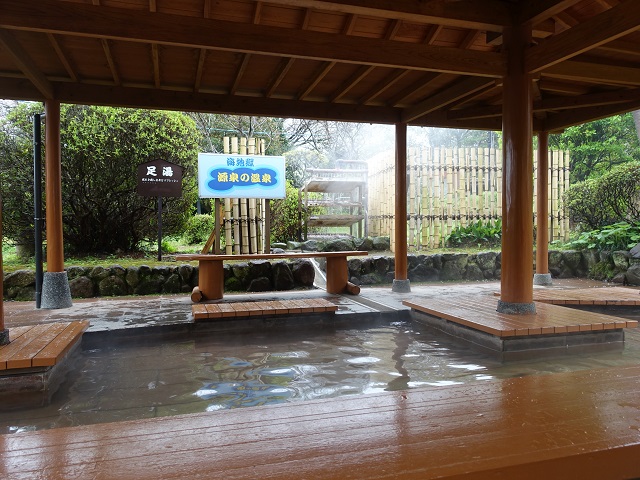
海地獄の足湯
The hot spring water is poured into the bamboo woven board in front of the building, cooled down, and then poured into the footbath.
Of course, it is 100% natural from the source.
Approximately 1.5 million liters of hot water is boiled out day and night, so the amount of hot water is quite abundant.
It has a roof, so you don’t have to worry about getting wet even if it’s raining.
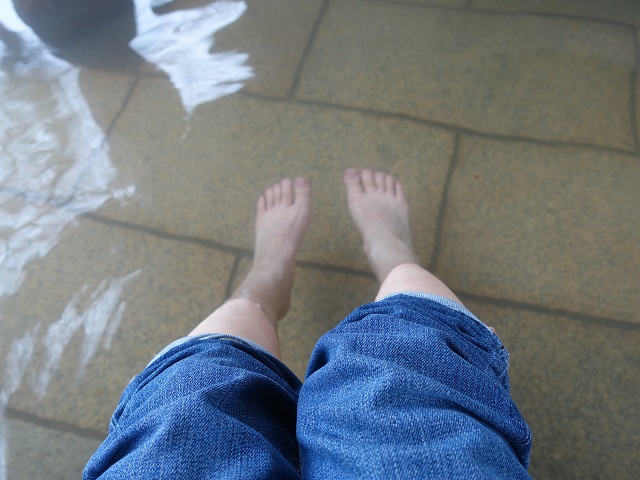
I liked the footbath space here as it was more spacious than the footbath space at Kamado Jigoku.
Then, as you go deeper than the footbath space, you will find a Umi Jigoku full of steam.
It’s located at the back of the souvenirs store.
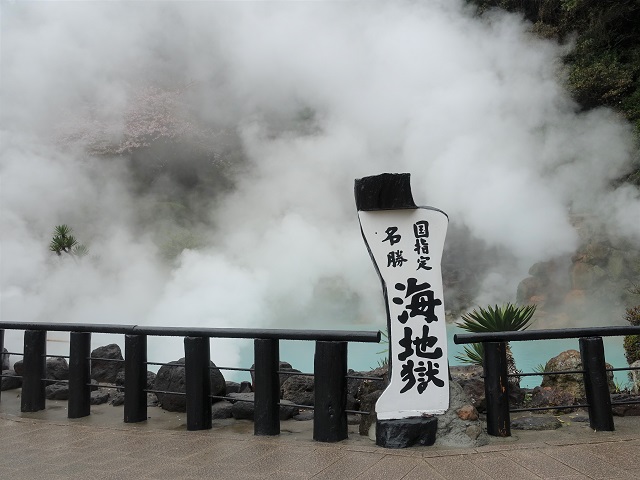
The origin of the name Umi Jigoku was not clearly stated on the website, but it is probably because the cobalt blue color of the water, in which iron sulfate is dissolved, is reminiscent of the ocean.
There were ponds with light blue hot water in other hells, but the size and amount of steam at this sea hell was on a different order of magnitude, and it was quite a sight to see.
The shop had a wide variety of items, so I had a hard time choosing souvenirs.
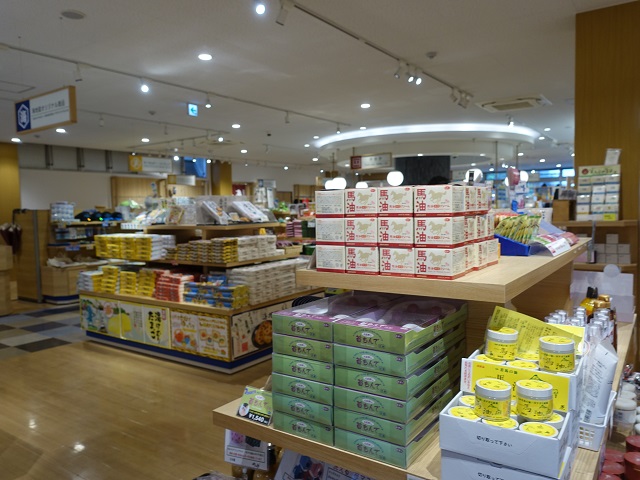
海地獄の品数豊富な売店
This is a souvenir that was popular with rice. ”Bungo beef”, Oita’s brand of beef, is marinated in sweet and salty sauce and is very delicious when eaten over rice.
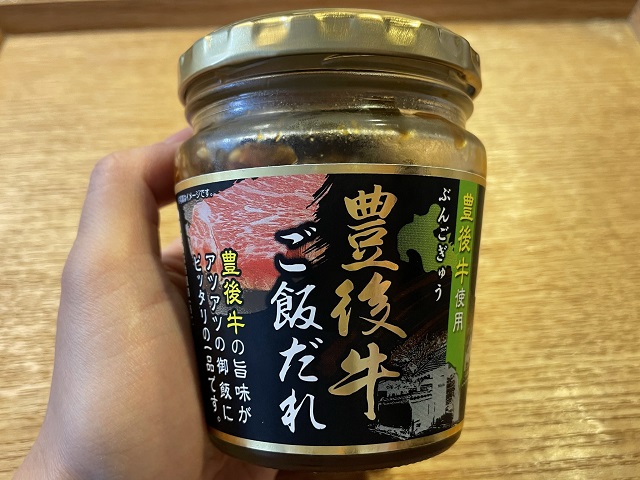
If you like pickles, this yuzu pickle is also delicious.
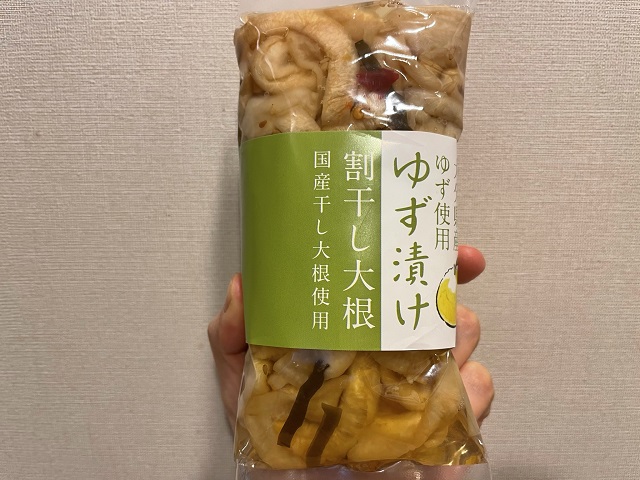
The Beppu-only barley shochu ”Aka Enma” was also delicious, so it’s recommended for shochu lovers.
Hot spring eggs made in the hot springs of Umi Jigoku are also a specialty.
鬼石坊主地獄(Oniishi Bouzu Jigoku)
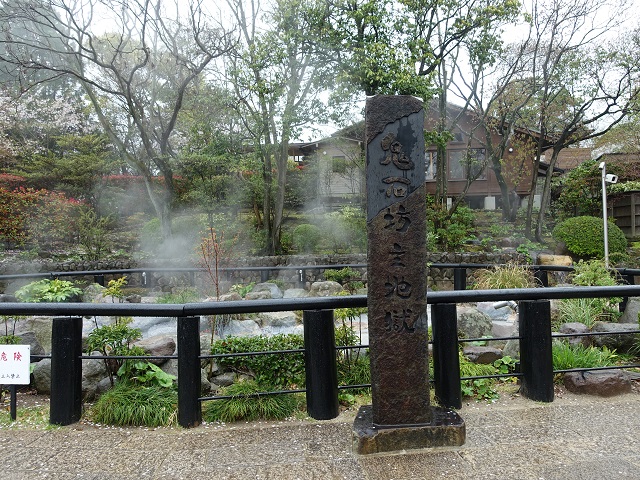
The fifth hell is Onishibozu Jigoku.
I’ve gotten used to Jigoku around here, but this place is a little different.
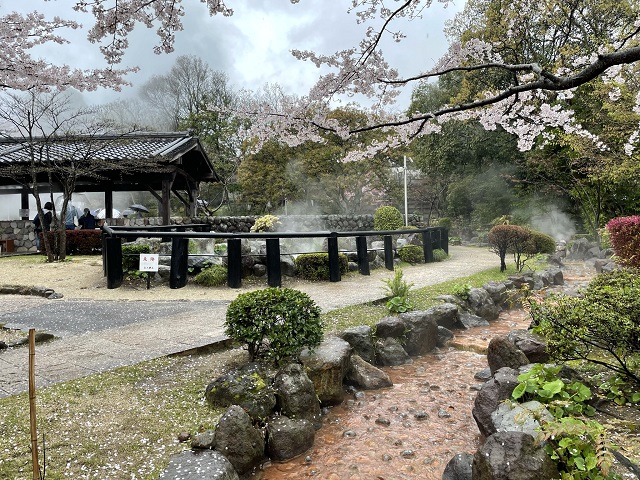
It seems to have appeared in literature around 733 D.C., so it has a long history.
At that time, it was said to be a truly hellish land where hot clay mud was spewing out from all over the fields, making it impossible for rice to grow.
It seems that it was only in the Meiji era that such land was developed and turned into a tourist facility.
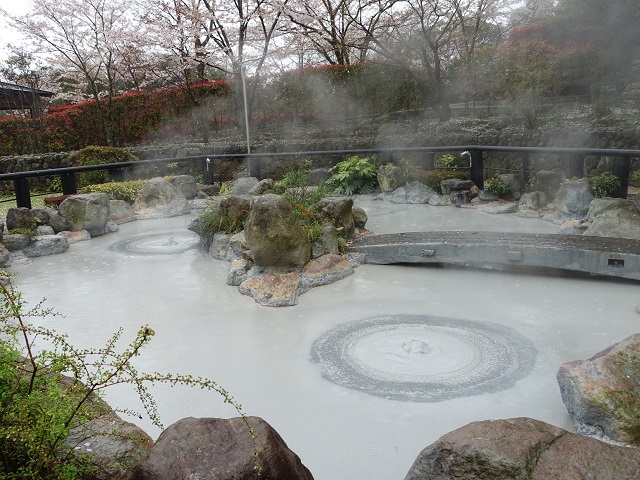
熱泥の湯玉
The sight of hot hot water bubbles peeking out from the clay water surface was a sight to behold.
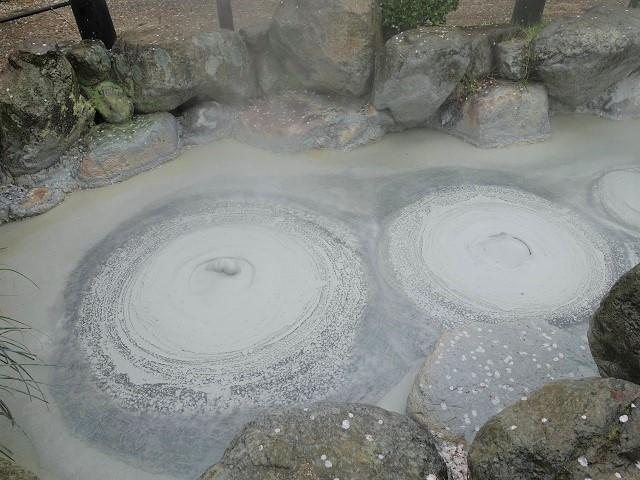
The footbath inside this facility looks like this.
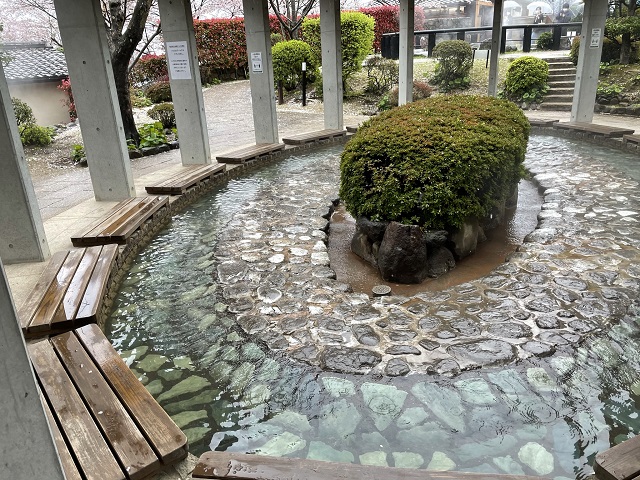
Next to the entrance to Onishi Bozu Jigoku, there is also a day-trip hot spring called Onishi no Yu.
Being able to take a bath and go home after touring hell is the best thing about Beppu!
Click here for information about ”Onishi no Yu”.
Please be respectful to other Onsen customers and follow the local rules.
Also, if you have a tatoo, you cannot to go public hotsprings like here, so please be careful.
If you feel difficult, you can try a private hotspring called “Kazoku buro”, so ask the reception.

鬼石坊主地獄の横にある鬼石の湯
The price is 620 yen for 1 adult.
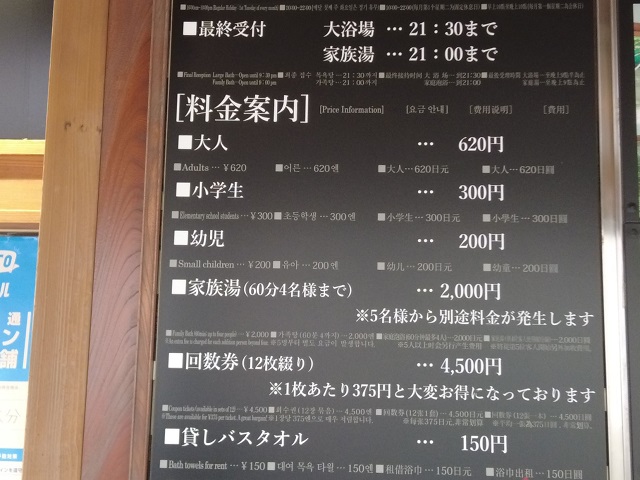
There are two other hells that you can enter with a common admission ticket.
Buses depart from Kannawa bus stop every 15 minutes, so if you are not coming by car, it is best to use that bus.
The remaining two hells were Blood Pond Hell and Geyser Tornado Hell, and although they were quite attractive, I decided not to go because I was at the limit of my physical strength and my next schedule was approaching.
[2024.03 add] It seems that you can rent a bike at Kannawa bus station. It is easier to visit 2 other Jigoku by bicycle.The Yutorin sightseeing express bus is convenient for traveling to Yufuin.
After enjoying the “Jigoku Meguri”, it is convenient to use the sightseeing express bus Yutorin to travel from Kannawa to Yufuin.
The Bus departs regularly from Kannawa bus stop.
It runs once every hour, so it’s best to check the departure time.
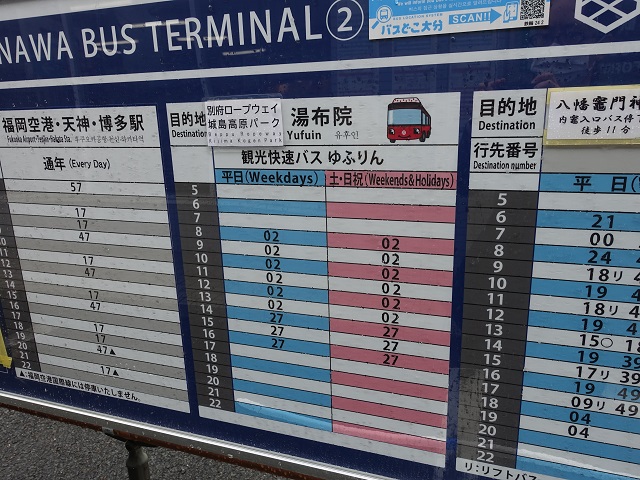
鉄輪発ゆふいん行きのゆふりん時刻表
When the bus arrived and we were getting on board, the bus usher was very kind and helped us carry our luggage onto the bus and waved us off at the end.
I was happy because I felt like I had received hospitality for the first time in a while.
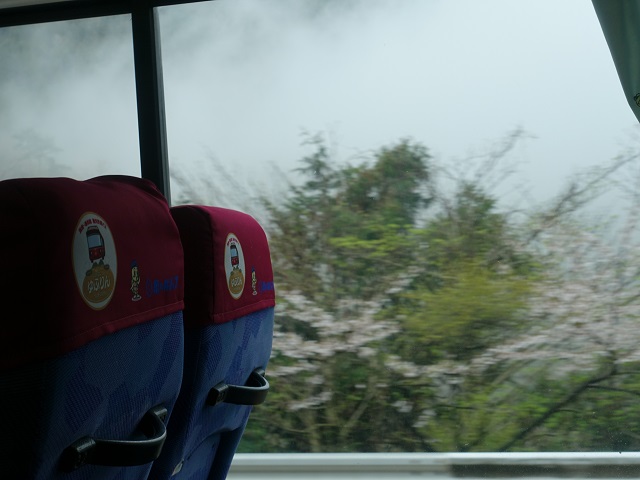
霧がかかった山道を進みます
Yufurin runs through the mountains as if crossing a mountain pass.
Continue along the road where you can see the mountains nearby,
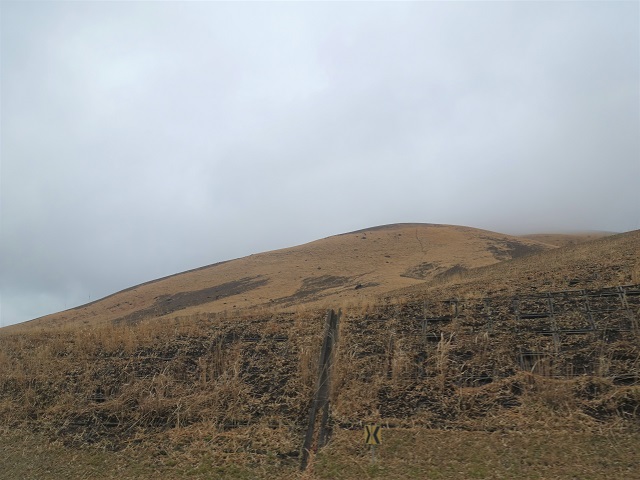
As you go down the winding road, you can see the city of Yufuin below. The scenery is very beautiful, so don’t forget to have your camera ready.
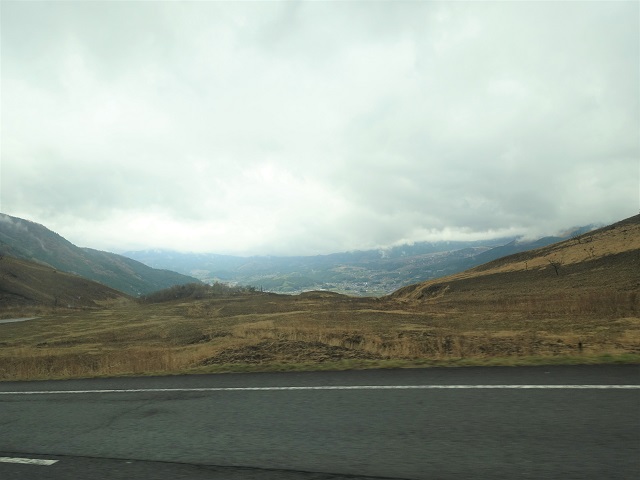
The town, which at first seemed quite low, quickly descends down the road and arrives at the town of Yufuin.
It takes about 40 minutes.
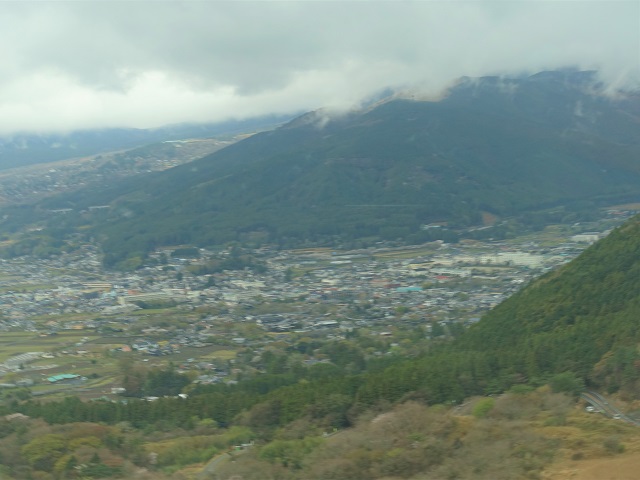
On the way, I realized that Yufuin is surrounded by mountains.
In Yufuin, there are many hot springs for day trips and lodgings where you can stay overnight, so you can choose one that suits your budget and schedule.
In Yufuin, there is a main street lined with souvenir shops called Yunotsubo Kaido, and a walking path that goes deeper into the main street.
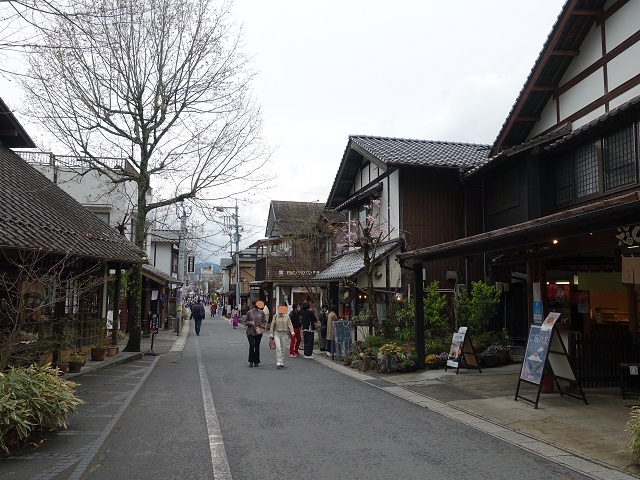
由布院の原宿「湯の坪街道」
For this trip, I wanted to focus on accommodation, so I stayed at Ryotei Tanokura.
I have written an article about my stay and my walk around Yufuin here.
